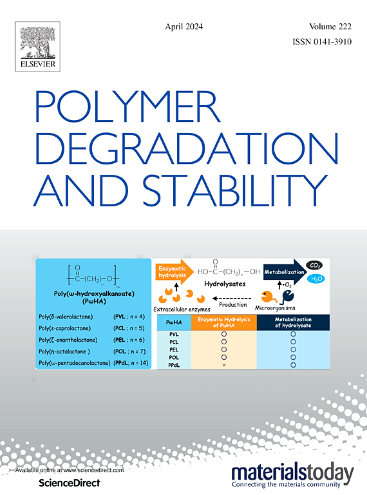Mechanoluminescence driven by oxidation reactions in epoxy resins
IF 6.3
2区 化学
Q1 POLYMER SCIENCE
引用次数: 0
Abstract
The luminescence of two imidazole or anhydride cured epoxy resins has been investigated under the combined effect of mechanical stress and temperature using a special experimental setup developed for this purpose. Rupture and cyclic mechanical tests have been conducted in air and in nitrogen between room temperature and 110 °C. Luminescence was acquired through both temporal and spectral acquisitions. Light emission is observed only in air, and fits a Zhurkov model of bond scission. Spectral measurements show that adding a mechanical component to a thermal stress does not excite new molecular groups, indicating that degradation mechanisms under thermal stress or both thermal and mechanical stresses could be similar. A simple two-step model is proposed to describe luminescence as a combination of bond scission and light decay.
环氧树脂中氧化反应驱动的机械发光
采用专门的实验装置,研究了两种咪唑或酸酐固化环氧树脂在机械应力和温度共同作用下的发光特性。在室温至110°C之间的空气和氮气中进行了断裂和循环力学试验。通过时间和光谱采集获得发光。光发射只在空气中观察到,并且符合键断裂的朱尔科夫模型。光谱测量表明,在热应力中加入机械成分不会激发新的分子基团,这表明热应力或热应力和机械应力下的降解机制可能相似。提出了一个简单的两步模型,将发光描述为键断裂和光衰减的结合。
本文章由计算机程序翻译,如有差异,请以英文原文为准。
求助全文
约1分钟内获得全文
求助全文
来源期刊

Polymer Degradation and Stability
化学-高分子科学
CiteScore
10.10
自引率
10.20%
发文量
325
审稿时长
23 days
期刊介绍:
Polymer Degradation and Stability deals with the degradation reactions and their control which are a major preoccupation of practitioners of the many and diverse aspects of modern polymer technology.
Deteriorative reactions occur during processing, when polymers are subjected to heat, oxygen and mechanical stress, and during the useful life of the materials when oxygen and sunlight are the most important degradative agencies. In more specialised applications, degradation may be induced by high energy radiation, ozone, atmospheric pollutants, mechanical stress, biological action, hydrolysis and many other influences. The mechanisms of these reactions and stabilisation processes must be understood if the technology and application of polymers are to continue to advance. The reporting of investigations of this kind is therefore a major function of this journal.
However there are also new developments in polymer technology in which degradation processes find positive applications. For example, photodegradable plastics are now available, the recycling of polymeric products will become increasingly important, degradation and combustion studies are involved in the definition of the fire hazards which are associated with polymeric materials and the microelectronics industry is vitally dependent upon polymer degradation in the manufacture of its circuitry. Polymer properties may also be improved by processes like curing and grafting, the chemistry of which can be closely related to that which causes physical deterioration in other circumstances.
 求助内容:
求助内容: 应助结果提醒方式:
应助结果提醒方式:


